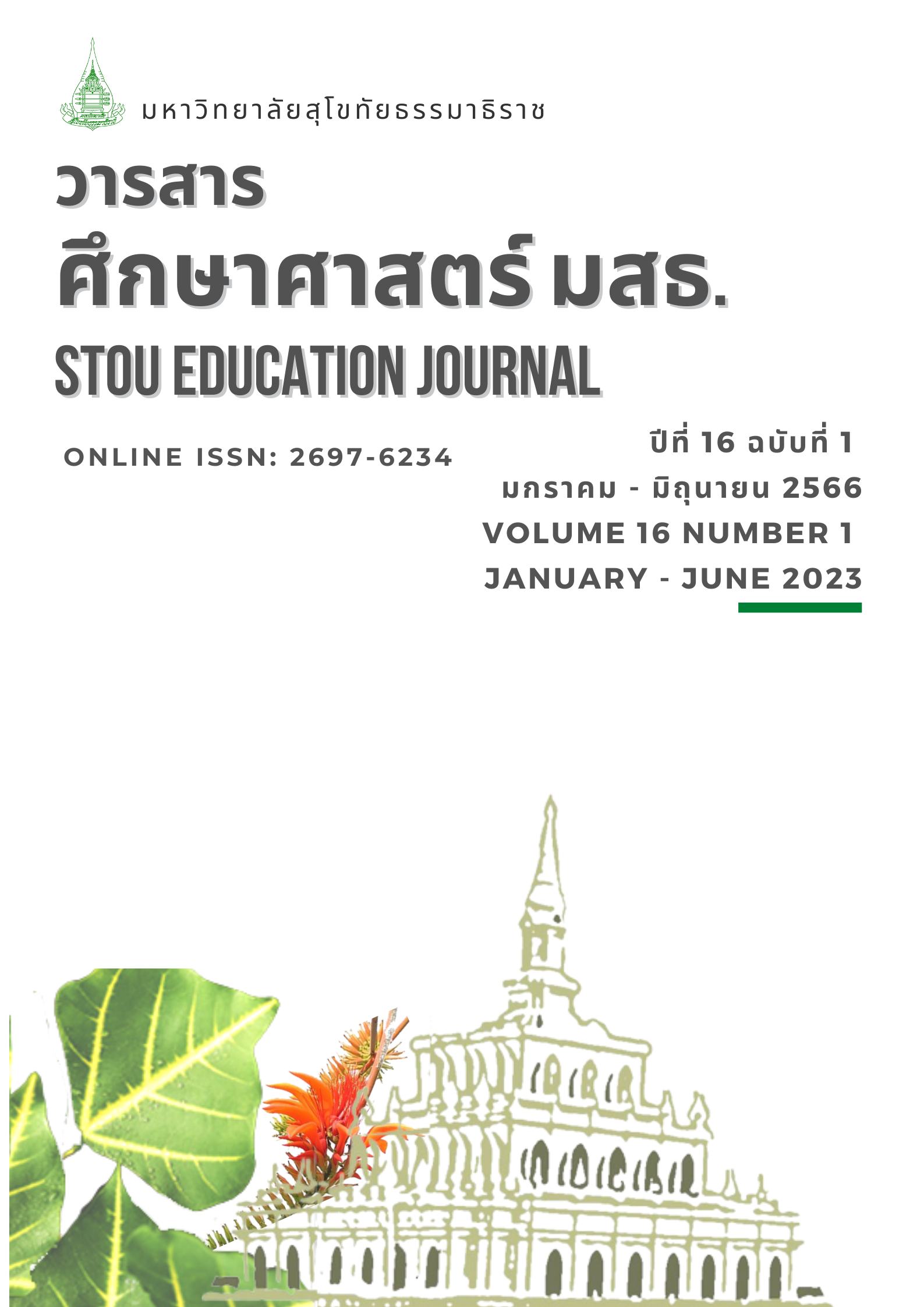Development of Chatbot Training Package for Enhancing Cyber Bullying Awareness for Sukhothai Thammathirat Open University's Students
Main Article Content
Abstract
The objectives of this research were 1) to develop an interactive Chatbot training package to enhance cyber bullying awareness for Sukhothai Thammathirat Open University students; 2) to study the efficiency of the interactive Chatbot training package; and 3) to study the satisfaction with the interactive Chatbot training package. Research informants for the development of the training package were 5 experts and 20 students at Sukhothai Thammathirat Open University. Research informants for the efficiency testing of the training package were 6 experts. The research sample in the study of satisfaction with the training package consisted of 33 Sukhothai Thammathirat Open University students. Research tools were question guidelines for focus group discussion, a training package performance assessment form, and a questionnaire on satisfaction with the training package. Data were analyzed using the frequency, percentage, mean, standard deviation, and content analysis. The research results were as follows: 1) the developed interactive Chatbot training package had the following components: (1) Chatbot Line named StopBullyBot, and (2) Chatbot Line menu consisting of six contents enhancing cyber bullying awareness: (2.1) bullying the others, (2.2) being bullied by the others, (2.3) having seen people bullying each other, (2.4) interesting web links and statistics, (2.5) a manual for using Chatbot, and (2.6) contacting us; 2) the efficiency testing results of the interactive Chatbot training package showed that the overall system of the training package was appropriate at the highest level, with the security aspect of the system having the highest appropriate rating mean, to be followed by the aspect of ability to meet the needs, and the aspect of performance efficiency of the system, respectively; and 3) the overall satisfaction with the interactive Chatbot training package of the students in the research sample was at the highest level.
Article Details
References
กัญจน์ เข็มนาค. (2565). การพัฒนาไลน์แชทบอทเพื่อให้ข้อมูลข่าวสารโรคติดต่อไวรัสโคโรนา. การประชุมวิชาการระดับชาติด้านคอมพิวเตอร์และเทคโนโลยีสารสนเทศ ครั้งที่ 18 (NCCIT 2022) (pp.346-351). กรุงเทพฯ : มหาวิทยาลัยเทคโนโลยีพระจอมเกล้าพระนครเหนือ.
จิราภา พึ่งบางกรวย. (2563). การรับรู้ความเสี่ยงและการแก้ปัญหาการถูกกลั่นแกล้งบนพื้นที่ไซเบอร์ของกำลังพลในกองทัพบก. วารสารวิชาการมนุษยศาสตร์และสังคมศาสตร์ โรงเรียนนายร้อยพระจุลจอมเกล้า, 7(1), 21-36.
ณัฐรัชต์ สาเมาะ, พิมพวัลย์ บุญมงคล, Timo T. Ojanen และรณภูมิ สามัคคีคารมย์. (2557). การรับรู้ของเยาวชนต่อการรังแกในพื้นที่ไซเบอร์. วารสารพฤติกรรมศาสตร์เพื่อการพัฒนา, 6(1), 352-363.
ธิดาภรณ์ อ่อนศรี. (26 มีนาคม 2564). การพัฒนาต้นแบบแชทบอทให้คำปรึกษาเบื้องต้นสาหรับผู้ป่วยโรคมะเร็ง. [Paper Presentation] การประชุมวิชาการระดับชาติวิทยาศาสตร์และเทคโนโลยีระหว่างสถาบัน ครั้งที่ 8 (ASTC 2021) ปทุมธานี: มหาวิทยาลัยราชภัฎวไลยอลงกรณ์ ในพระบรมราชูปถัมภ์.
นวภัทร ศุภศีลวัต. (2560). การพัฒนาระบบ Chatbot ในการค้า เพื่อการส่งข้อความออนไลน์. [สารนิพนธ์ วิทยาศาสตรมหาบัณฑิต ไม่ได้ตีพิมพ์]. มหาวิทยาลัยเทคโนโลยีพระจอมเกล้าพระนครเหนือ.
น้ำมนต์ เรืองฤทธิ์. (2560). อินโฟกราฟิกกับการออกแบบสื่อการสอน. วารสารศึกษาศาสตร์ มหาวิทยาลัยศิลปากร, 15(2), 29-40.
เมธินี สุวรรณกิจ. (2560). มาตรการทางกฎหมายในการคุ้มครองเด็กและเยาวชนจากการถูกกลั่นแกล้งในสังคมออนไลน์. วารสารนิติศาสตร์ มหาวิทยาลัยนเรศวร, 10(2), 49-70.
วรัญญา เดชพงษ์. (2563). การศึกษาผลกระทบของการใช้อินโฟกราฟิกเป็นสื่อในการเรียนการสอนของนักเรียนระดับชั้นมัธยมศึกษา กรณีศึกษาโรงเรียนในเขตกรุงเทพมหานคร. วารสารนิเทศศาสตรปริทัศน์, 24(3), 274-282.
สถาบันสื่อเด็กและเยาวชน และ สำนักงานกองทุนสนับสนุนการสร้างเสริมสุขภาพ. (2561). ความฉลาดทางดิจิทัล (DQ Digital Intelligence). มูลนิธิส่งเสริมสื่อเด็กและเยาวชน พญาไท.
สรานนท์ อินทนนท์ และ พลินี เสริมสินสิริ. (8 มิถุนายน 2560). การศึกษาวิธีการป้องกันการกลั่นแกล้งบนโลกไซเบอร์ของวัยรุ่น. [Paper Presentation] การประชุมวิชาการและนำเสนอผลงานวิชาการระดับชาติ UTCC Academic Day ครั้งที่ 2. University of Commmerce.
อุบล สาธิตกร, วิภา เกตุเทพา, สุภรณ์ แขตระกูล, ศศกร วิชัย, และ อรนุช กาญจนประกร. (2563). การสนทนากลุ่ม, 13 พฤศจิกายน 2563.
Brown, T. (2021). The future of chatbots in customer service. Journal of Business and Technology, 12(4), 56-62.
Cross, D. S., Smith, P. K., & Campbell, M. A. (2017). Cyberbullying: A review of the literature. Journal of Adolescent Health, 61(4), 446-455. https://doi.org/10.1016/j.jadohealth.2017.05.011
Hinduja, S., & Patchin, J. W. (2015). The impact of cyberbullying on youth: A review of the literature. Youth & Society, 47(3), 325-347. https://doi.org/10.1177/0044118X14567453
Hinduja, S., & Patchin, J. W. (2017). Cyberbullying in schools: A review of the literature. Journal of School Violence, 16(1), 36-56. https://doi.org/10.1080/15388220.2015.1108513
Huesmann, M. F., Banning, J. H., Deckman, T., & Troop-Gordon, W. (2018). Cyberbullying among adolescents: A review of the literature. Aggression and Violent Behavior, 39, 73-82. https://doi.org/10.1016/j.avb.2018.05.006
Johnson, R. (2022). The impact of chatbots on e-commerce sales. TechTrends. https://www.techtrends.com/chatbots-impact-e-commerce-sales.
McTar, M. (2018). Conversational Modelling for Chatbot : Current Approaches and Future Directions. http://webcache.googleusercontent.com/search?q=cache:g47Icy7_6_MJ:spokenlanguagetechnology.com/docs/McTear_ESSV_2018.pdf+&cd=1&hl=en&ct=clnk&gl=th
Shariff, S. (2008). Cyber-Bullying: Issues and solutions for the school, the classroom and the home. Routledge.
Smith, J. (2020). Chatbot development process: Best practices and guidelines. O'Reilly Media, Inc.
Tavanapour, N., & Bittner, E. A. (2018). Automated facilitation for idea platforms: design and evaluation of a Chatbot prototype. https://aisel.aisnet.org/icis2018/general/Presentations/8/


